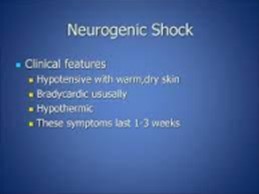A client has sustained a T4-T5 injury and the nurse suspects he is in neurogenic shock. Which of the following manifestations are consistent with neurogenic shock? Select All that Apply
A hypertension
B rapidly elevating temperature
C bradycardia
D fixed and dilated pupils
E hypotension
Correct Answer : C,E
Choice A Rationale: Hypertension is not a sign of neurogenic shock, but rather of autonomic dysreflexia, a life-threatening condition that can occur in patients with spinal cord injury above T6.
Choice B Rationale: Rapidly elevating temperature is also a sign of autonomic dysreflexia, not neurogenic shock. Neurogenic shock can cause hypothermia due to impaired thermoregulation.
Choice C Rationale: Bradycardia is a sign of neurogenic shock due to the loss of sympathetic stimulation to the heart, which normally increases the heart rate and contractility.
Choice D Rationale: Fixed and dilated pupils are a sign of brain death, not neurogenic shock. Neurogenic shock can cause miosis (constriction of the pupils) due to unopposed parasympathetic stimulation.
Choice E Rationale: Hypotension is a sign of neurogenic shock due to the vasodilation and decreased venous return caused by the loss of sympathetic tone.

Nursing Test Bank
Naxlex Comprehensive Predictor Exams
Related Questions
Correct Answer is A
Explanation
Choice A Rationale: The patient who developed a new cough after eating breakfast should be seen first. This sudden change in respiratory status during or after eating suggests a potential risk of aspiration, which requires immediate assessment and intervention to prevent respiratory distress or pneumonia.
Choice B Rationale: Medication refusal, while important, is not an immediate life threatening issue compared to a new cough with the potential for aspiration.
Choice C Rationale: Although constipation can be uncomfortable, it is not an acute priority compared to a new cough that may indicate a respiratory problem.
Choice D Rationale: A stage II pressure ulcer on the coccyx, while concerning, is not an immediate priority over a potential respiratory issue that requires urgent attention.
Correct Answer is B
Explanation
Choice A Rationale: Notifying the physician may be necessary if troubleshooting the issue does not resolve the problem, but it is not the initial step.
Choice B Rationale: The nurse should first check the tubing of the indwelling urinary catheter for any kinks, twists, or obstructions that might prevent the urine flow. This is a simple and non-invasive intervention that can resolve the problem quickly and easily.
Choice C Rationale: Removing the indwelling catheter is not advisable without proper assessment and intervention, as it can lead to complications.
Choice D Rationale: Replacing the indwelling catheter is not the first step and should only be done if the problem cannot be resolved through assessment and interventions.
Whether you are a student looking to ace your exams or a practicing nurse seeking to enhance your expertise , our nursing education contents will empower you with the confidence and competence to make a difference in the lives of patients and become a respected leader in the healthcare field.
Visit Naxlex, invest in your future and unlock endless possibilities with our unparalleled nursing education contents today
Report Wrong Answer on the Current Question
Do you disagree with the answer? If yes, what is your expected answer? Explain.
Kindly be descriptive with the issue you are facing.
